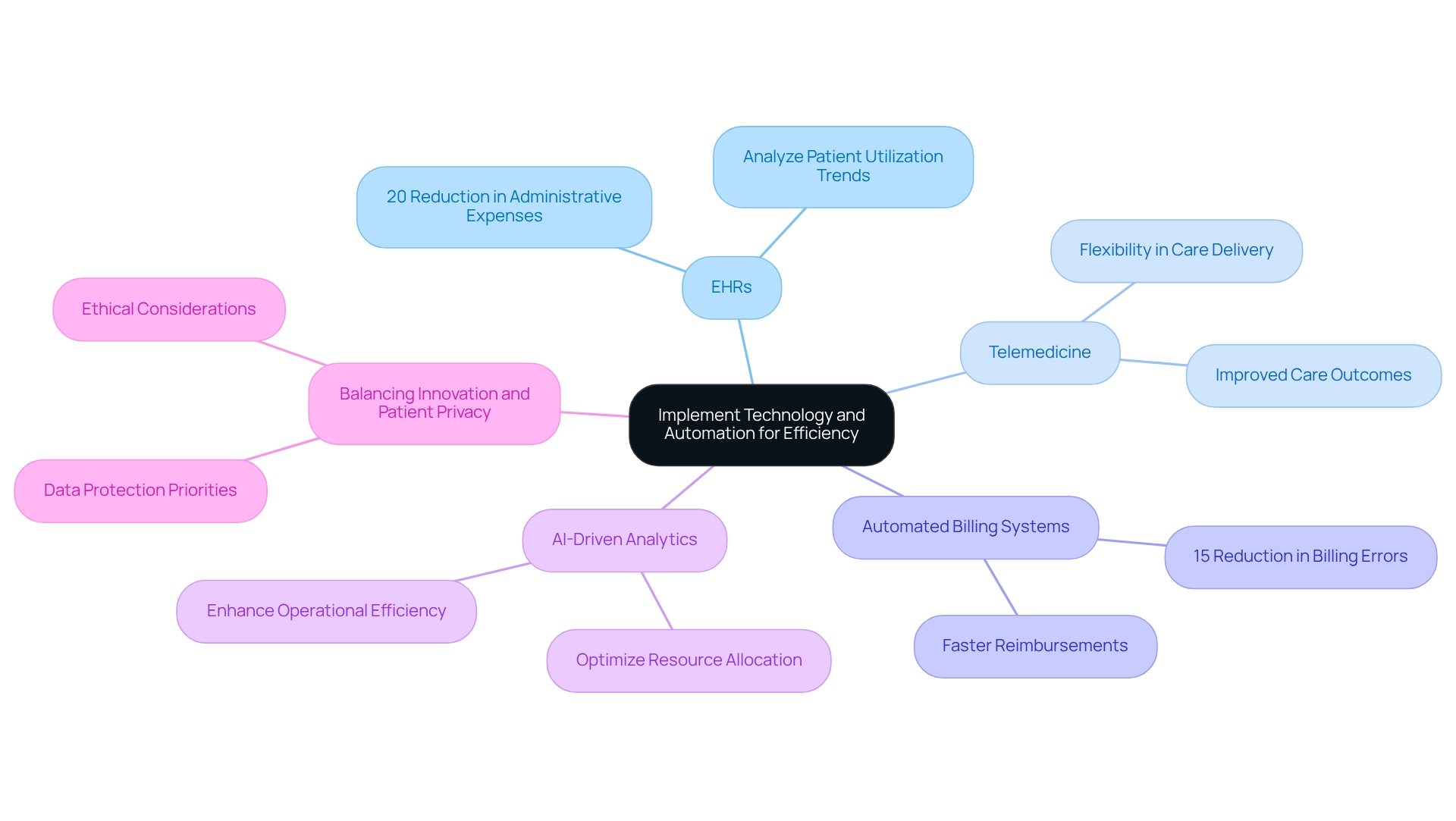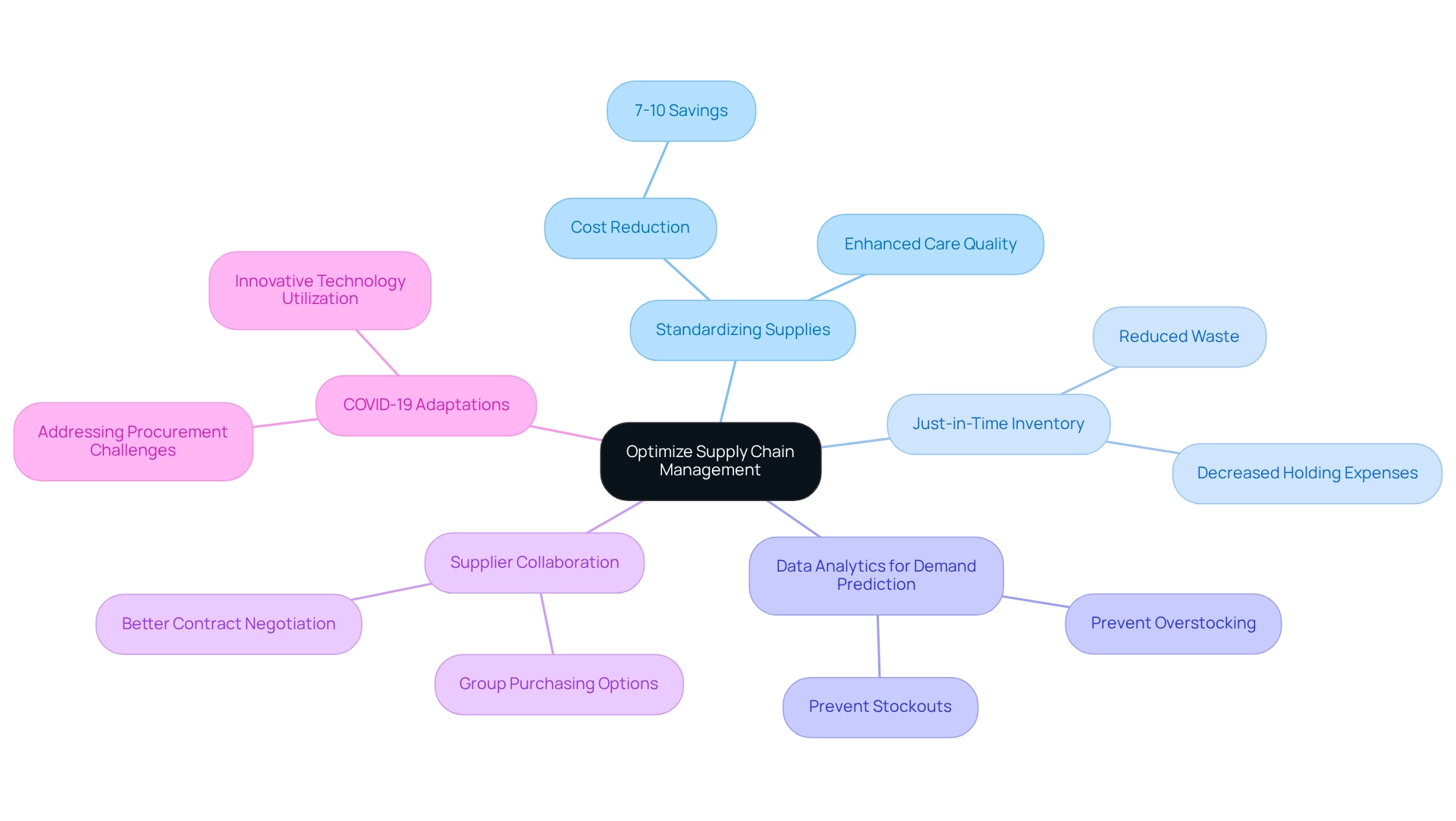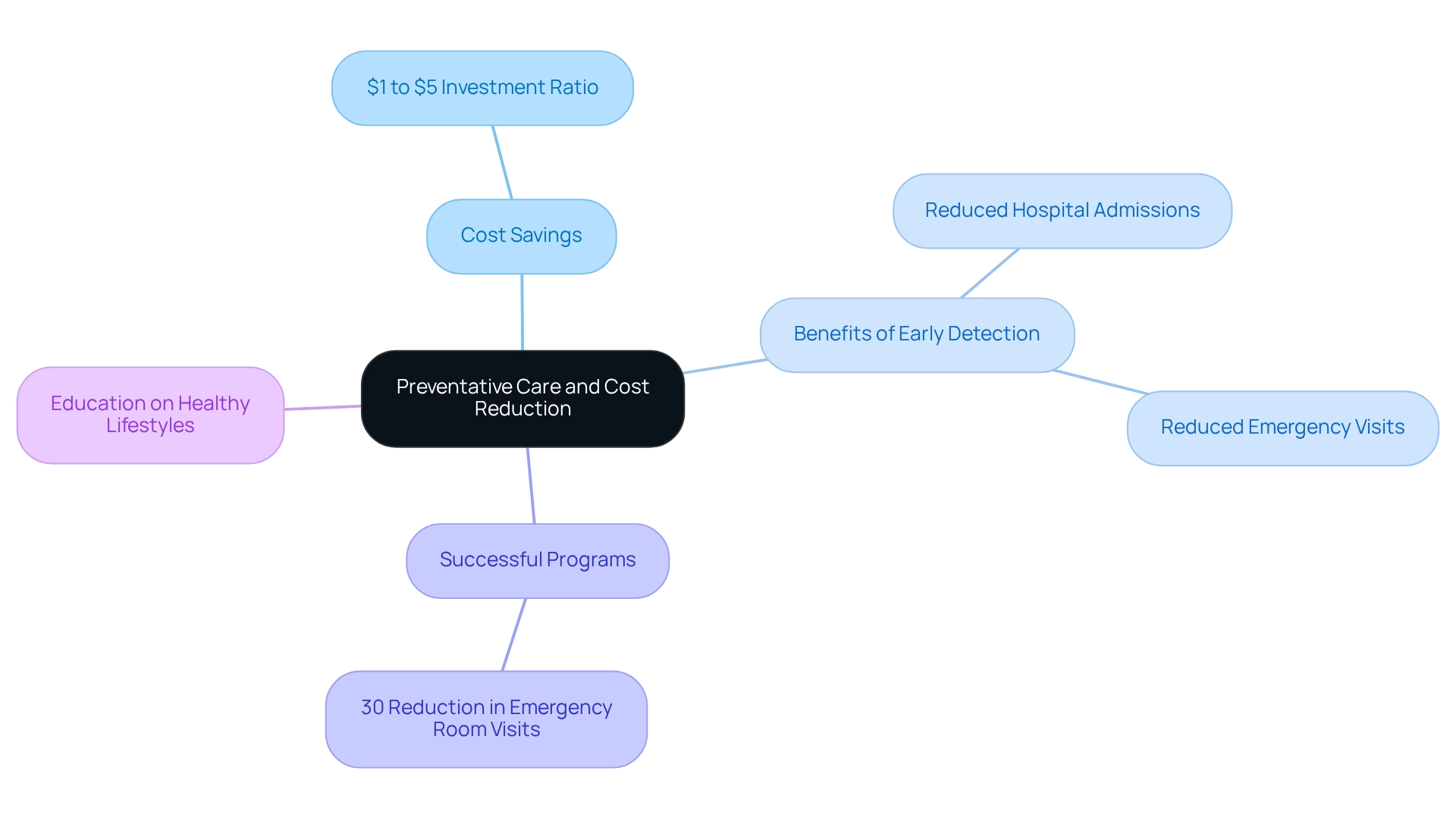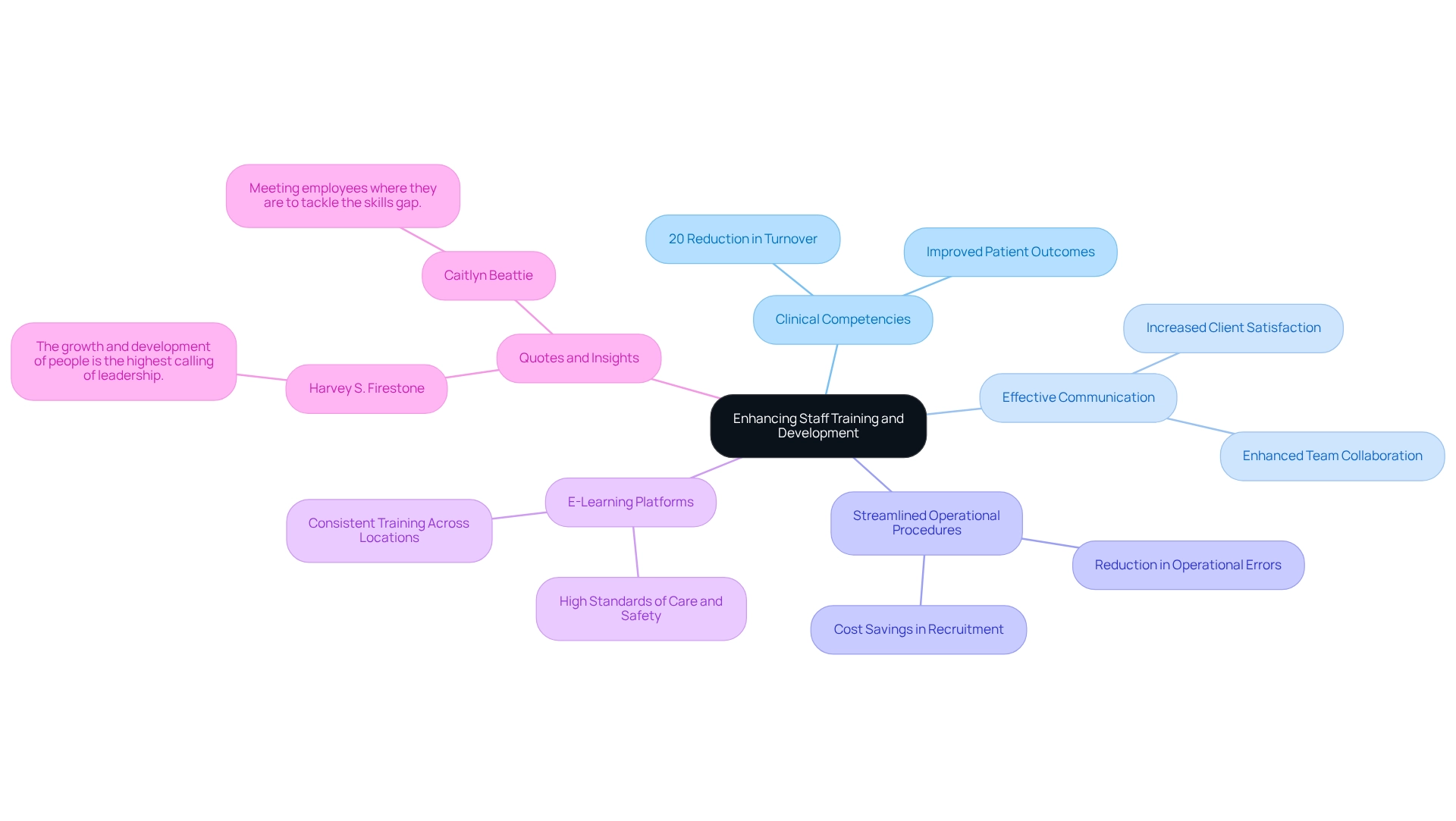Overview
The article presents four key strategies for reducing costs and enhancing efficiency in healthcare:
- Technology integration
- Supply chain optimization
- Preventative care
- Staff training
These strategies are not merely theoretical; they are backed by substantial evidence demonstrating their effectiveness. For instance, the implementation of electronic health records has resulted in significant cost savings, while preventative care programs have proven to enhance operational efficiency. By embracing these approaches, healthcare settings can achieve notable reductions in expenses, ultimately leading to improved patient outcomes and a more sustainable operational model.
Introduction
In an era where healthcare costs continue to soar, organizations face mounting pressure to discover innovative solutions that foster efficiency and sustainability. By embracing technology and automation, optimizing supply chain management, prioritizing preventative care, and enhancing staff training, healthcare providers can substantially reduce expenses while simultaneously improving patient outcomes.
This article explores strategic approaches that not only decrease costs but also elevate the quality of care, ultimately paving the way for a more resilient healthcare system. Drawing insights from industry experts and case studies, it underscores the necessity of adapting to evolving demands and leveraging data-driven strategies to navigate the complexities of modern healthcare.
Implement Technology and Automation for Efficiency
To achieve cost reduction in healthcare, entities must efficiently lower expenses in medical services by emphasizing the incorporation of technology and automation. This encompasses the adoption of electronic health records (EHRs), telemedicine platforms, and automated billing systems. Notably, hospitals that have adopted EHRs have reported reductions in administrative expenses by as much as 20%. EHRs also enable medical organizations to examine patient utilization patterns, thereby aiding in effective resource distribution.
Furthermore, automation in billing and coding minimizes errors, resulting in faster reimbursements and contributing to cost reduction in healthcare through lower overhead costs. A significant case study from a prominent medical provider demonstrated that automating revenue cycle management led to a 15% reduction in billing errors, resulting in considerable annual savings. Moreover, utilizing AI-driven analytics can optimize resource allocation and client management, which can lead to cost reduction in healthcare while further enhancing operational efficiency.
As Margaret E. O’Kane noted, value-based arrangements with providers and plans at risk create the flexibility to design models that utilize telehealth where and when it can help improve care and outcomes.
As healthcare institutions adopt these advancements, they must also manage the balance between innovation and patient privacy, ensuring that data protection remains a priority. This balance is crucial as the healthcare landscape continues to evolve, and organizations strive to implement solutions that not only enhance efficiency but also safeguard patient information.

Optimize Supply Chain Management to Cut Costs
By optimizing their supply chain management, healthcare organizations can achieve substantial savings, leading to cost reduction in healthcare. Standardizing supplies across departments can result in cost reduction in healthcare, leading to savings of 7-10% while enhancing care quality. Additionally, adopting just-in-time inventory systems supports cost reduction in healthcare by decreasing holding expenses and reducing waste.
For instance, a hospital that implemented a centralized purchasing system reported a 12% decrease in supply expenses within the first year. Furthermore, utilizing data analytics to predict demand assists organizations in preventing overstocking and stockouts, ensuring resources are accessible when needed without incurring excessive expenses.
Collaborating with suppliers to negotiate better contracts and exploring group purchasing options can contribute to cost reduction in healthcare and enhance cost efficiency. As CareSet integrates more than 100 external data sources for its analysis, leveraging such data-driven insights is crucial for effective supply chain management.
Moreover, the COVID-19 pandemic has intensified current procurement challenges, underscoring the necessity for more intelligent procurement strategies to address gaps in the supply chain. As Lisa Miller, a consultant and speaker, observes, “Effective supply chain management is essential for the successful operation and profitability of medical entities, yet most find it challenging to attain.”
These strategies will be essential for organizations aiming to optimize their supply chain management and enhance overall operational effectiveness in 2025.

Focus on Preventative Care to Minimize Future Expenses
Shifting focus towards preventative care represents a strategic approach to achieving cost reduction in healthcare by minimizing future medical expenses. By investing in early detection and management of chronic diseases, medical systems can effectively contribute to cost reduction in healthcare by avoiding costly interventions later on.
Research indicates that for every dollar invested in preventative care, there is potential for cost reduction in healthcare by saving up to $5 in future medical expenses. Implementing regular screenings and wellness programs facilitates early diagnosis and treatment, which is essential for cost reduction in healthcare by significantly reducing hospital admissions.
For instance, a medical organization that launched a comprehensive preventative care program reported a remarkable 30% reduction in emergency room visits over two years, highlighting the significant cost reduction in healthcare that such initiatives can achieve. Furthermore, educating individuals about healthy lifestyle options can enhance the effectiveness of preventative care strategies.

Enhance Staff Training and Development for Cost Efficiency
Enhancing employee training and development is essential for achieving cost reduction in healthcare. Organizations must invest in comprehensive training programs that concentrate on:
- Clinical competencies
- Effective communication with individuals
- Streamlined operational procedures
Research indicates that hospitals prioritizing staff training see a 20% reduction in turnover rates, translating to substantial savings in recruitment and onboarding costs. For example, a medical facility that implemented a continuous professional development program noted significant improvements in client satisfaction scores and a decrease in operational errors.
Moreover, cultivating a culture of ongoing education empowers staff to identify inefficiencies and contribute to cost reduction in healthcare initiatives, ultimately elevating the overall quality of care. As Harvey S. Firestone aptly stated, “The growth and development of people is the highest calling of leadership,” underscoring the critical importance of staff development in the medical sector.
Additionally, e-learning platforms enable consistent training across multiple locations, ensuring that all staff receive the same quality education, regardless of geographical constraints. This consistency is crucial for maintaining high standards of care and safety, thereby supporting continuous improvements in healthcare training programs.
Addressing the skills gap by meeting employees where they are, as highlighted by Caitlyn Beattie, is vital for effective training strategies. By leveraging comprehensive insights, organizations can make data-driven decisions that enhance training programs and ultimately lead to improved patient outcomes.

Conclusion
Innovative strategies are essential for healthcare organizations aiming to reduce costs while enhancing patient outcomes. Central to this endeavor is the integration of technology and automation—tools such as electronic health records and telemedicine streamline operations and minimize administrative expenses, resulting in significant savings.
Another critical area for cost reduction is optimizing supply chain management. By standardizing supplies and implementing just-in-time inventory systems, healthcare providers can improve resource allocation and achieve substantial savings. The challenges revealed during the COVID-19 pandemic have highlighted the necessity of strategic procurement and collaboration with suppliers.
Focusing on preventative care is vital for long-term cost savings. Investing in early detection and management of chronic diseases can drastically decrease the need for costly interventions, while wellness programs and patient education foster healthier communities and lower expenses.
Moreover, enhancing staff training and development is crucial for operational efficiency. Comprehensive training programs not only improve clinical competencies but also empower staff to identify inefficiencies, cultivating a culture of continuous improvement.
In conclusion, a resilient healthcare system is built upon the strategic use of technology, optimized supply chains, a commitment to preventative care, and robust staff development. By embracing these interconnected approaches, healthcare organizations can effectively navigate modern challenges, ensuring sustainability and improved patient outcomes for the future.


